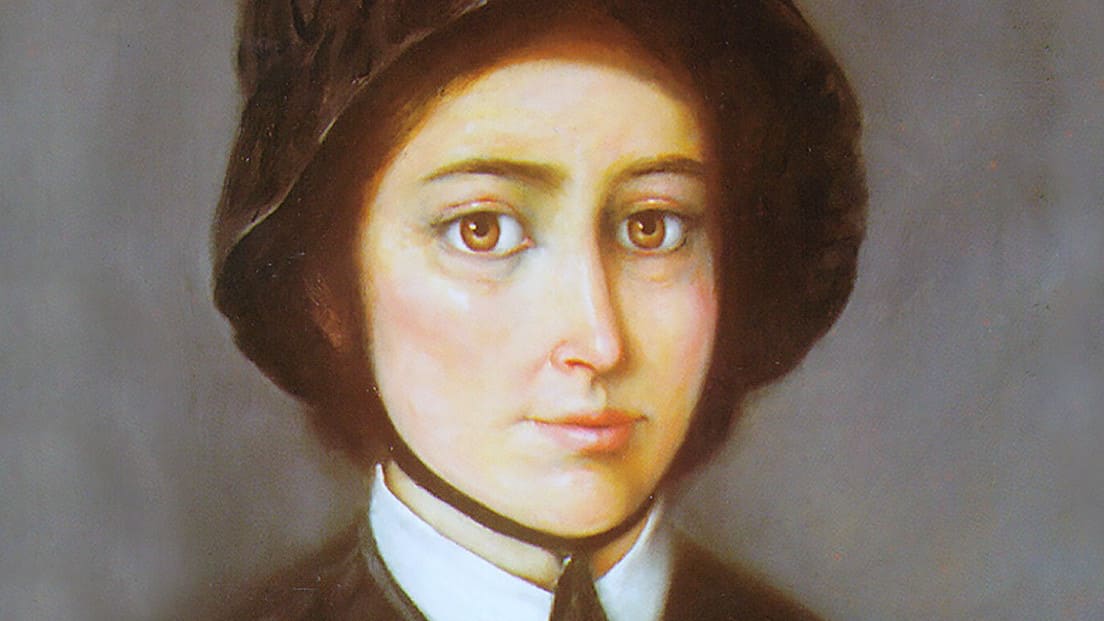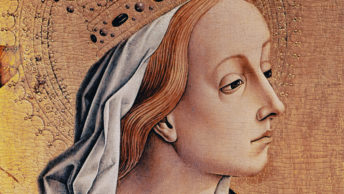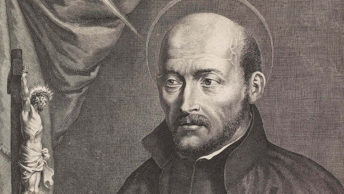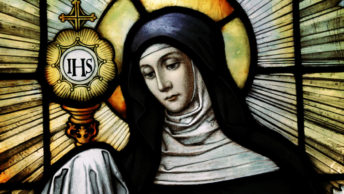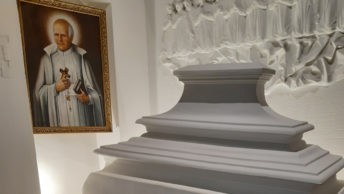Most people think saints are overly devout and pious people who spent most of their lives on their knees or walking around with their hands folded and their eyes cast downward. Such depictions only make sainthood less interesting and seemingly unattainable for ordinary people. The world needs lay men and women who have confronted the world in such a way that they transcend everyday things and inspire ordinary people.
The Love of the Game
The average American has a misconception of sainthood that borders on universal salvation. As soon as a celebrity or close relative dies they envision that person playing golf with St. Peter or touring Heaven with new wings. The Church, however, teaches that God has prepared a place in Heaven for all of his creatures who have been faithful to His word. In effect God has called all people to be saints and spend eternity with Him.
While it may be difficult to give an exact number of official saints, the latest edition of Butler’s Lives of the Saints contains the lives of 2,565 saints from a few billion Christians. Many are called, but few are chosen.
This does not imply that anybody has been eliminated from the supernatural joys of Heaven simply because of their lack of extraordinary skill or devotion. Last year Time magazine published a list of people they thought would become saints. Most of their selections were the usual array of popes, nuns and other religious figures. Time did surprise its readers with its inclusion of a married couple who were chosen because they were parents. Louis and Marie-Azelie Guerin Martin were not run-of-the-mill parents nor were their daughters ordinary. All five became nuns. One of them was St. Therese of Lisieux, the little flower of Jesus, one of the most revered of all saints.
A Divine Embrace
Despite the Martins’ personal holiness, their five-year vow of marital celibacy at the start of their marriage removes them as practical role models for married couples. The Church needs saints today who will resonate better with lay people who struggle with the ordinary sins and temptations of daily living.
During a 1965 conference for the Catholic Lay Extension Volunteers, Sister Charles Borromeo proposed a unique way of looking at human beings that touched on a more universal notion of sainthood. She spoke of an eighth sacrament. By definition the seven traditional sacraments are visible signs instituted by Christ to give grace. In light of the ecumenism of the Sixties she expanded this definition to include the human being as the only sacrament that all Catholics and non- Catholics alike are free to receive.
This was not her radical way of confusing or twisting traditional theology but a novel way of looking at the human person that portended Pope John II’s Personalism. Her teachings also underscored human beings as messengers of God’s grace. Everyone has been entrusted with the salvation of others by letting the joy of the Lord in their hearts flow out to the suffering and searching souls around them. While most of God’s saintly messengers will never be canonized, their road to Heaven is just as valid as those of the martyrs and all the canonized saints in Heaven.
What Christians need today are men and women whose interior life, struggles and sinfulness have brought them to a divine embrace. It needs saints whose demeanor, integrity, honor, playfulness and deep longing for God will personally inspire not only ordinary Catholics but also all inhabitants of the world. Writers Gilbert Keith Chesterton, Flannery O’Connor and Walker Percy meet this standard. They all had an itch in their soul that transformed them from doubters and sinners to pilgrims on the road to salvation.
A Friend of God
Born in London in 1874, the rotund Chesterton was a prolific author whose essays, novels, poetry, plays and Christian apologetics continue to delight and enlighten millions of readers around the world long after his death of congestive heart failure in 1936. The old adage that the pen is mightier than the sword accurately describes Chesterton’s life. His paradoxical essays and books attracted more people to the Church than the most valiant warriors of all the Crusades to the Holy Land.
While Chesterton was too modest to ever think himself a saint, he knew what set saints off from all other Christians. In his biography St. Francis of Assisi he wrote that a saint is not what the people want but rather what the people need. The saint is often mistaken for a poison even though he is the perfect antidote for the modern ailments of materialism, profligacy and loss of faith.
Chesterton’s brilliance flowed from his uncanny mastery of a wide variety of ideas and his absolute command of the English language. In his book G.K. Chesterton: A Biography, Father Ian Ker wrote: the Church is looking for heroism, and Chesterton was heroic in his journalism and in his apostleship.
Father Robert Wild compared Chesterton to St. Francis of Assisi in his book The Tumbler of God: Chesterton as Mystic. Father Wild believes that both the saint and the writer had a deep friendship with God because they loved the splendor of the real. To Chesterton faith was a vision of reality. He was not an ascetic mystic like St. Francis, who gained his spiritual insight through exceptional self-denial in the religious life.
To the contrary, Chesterton disdained asceticism that renders one incapable of spontaneity and joy. He had a contagious happiness and inner peace that energized his writings and inspired his readers. Father Wild said he was a bright morning star of authentic Catholic mysticism in the 20th century. Yet he did not seek the mysteries of God in the solitude of the monastery but fully confronted the world as it was. As a result he was able to witness the faith as an insider who could extend his spirit of wonder to all those around him.
A Prayer for God
An active prayer life has always been a viable road to sainthood. Born in 1925 in Savannah, Georgia Mary Flannery O’Connor followed a near-mystical routine of humble prayer that inspired her to see God’s love in all her daily experiences. Her father’s death from systemic lupus erythematosus in 1941 served as a portent of her own premature death in 1964.
After being diagnosed with lupus in 1951 O’Connor returned to her ancestral farm, Andalusia, in Milledgeville, Georgia. The comfort of her farm, tempered by a monastic way of life, which included daily Mass, increased her life expectancy from the usual 5 years to 13. O’Connor had the same fascination with animals that St. Francis did. She raised several species of ducks, ostrich, emus and toucans while incorporating images of peacocks into her stories. She spent these last years in Milledgeville mostly on crutches as her disease ravaged her bones and joints.
Despite a relatively sheltered life her writings reveal an uncanny grasp of the variegated depths of human behavior. O’Connor’s writings accentuated her Catholic vision of life. She sought to uncover mystery through manners, grace through nature. Most of her work featured the raw and powerful effects of sin on the human mind or what she called Christian realism.
O’Connor’s allegorical fiction was situated in the rural Christ-haunted South of the mid-20th century. To her the world was battered by sin but was putting up quite a battle against its redemption. She drew most of her characters from the weathered and withered poor around her. While most were deceptively backward characters, their inner transformation of character through violence, pain or the vicissitudes of life in the pursuit of the divine signaled to O’Connor the universal truth that for all its horror the world was found by God to be worth dying for.
O’Connor’s body of work was small in size but her short stories and two novels comprise a rich legacy that exposes the underbelly of the human condition with her unique wit, clarity and sympathy. Her novel Blood Wise is positively Dostoevskian. While her talent was recognized during her lifetime, her critics sometimes mischaracterized her work as nothing more than Tobacco Road meets Edgar Allan Poe.
In her sickness and suffering she experienced the Christ of her faith firsthand. With a reverse Augustinian echo she beseeched the Lord to make me a mystic, immediately. Her lack of pride saturated her prayers. I do not know you God because I am in the way. Please help me to push myself aside. Her personal prayer journal was recently discovered among her papers in Georgia and published in November 2013. Written between 1946 and 1947 while she was a student at the University of Iowa, A Prayer Journal is a rare gateway into her interior life.
God’s Messenger
Like O’Connor, novelist Walker Percy was part of the Southern Literary Renaissance. Born in Birmingham, Alabama in 1916, Percy was haunted by the suicides of both his grandfather and his father before his 14th birthday. When his mother later drowned under mysterious circumstances, he and his two brothers went to live with their eccentric and literary Uncle Will.
While attending medical school Percy contracted tuberculosis and spent the better part of three years bedridden. During his convalescence he read extensively Sartre, Dostoevsky, Kierkegaard and St. Thomas Aquinas. It was the latter’s Summa Theologica that led him to the threshold of the Catholic Church.
After his recovery and departure from medicine, Percy became a philosophical novelist. He also married and converted to the Church along with his new bride. Catholicism empowered him with a probing vision that was enhanced by his moral gravity and his ability to tell stories. His first novel, The Moviegoer, was an enormous success and won the National Book Award in 1962.
Over the next twenty-five years Percy published five novels that diagnosed the modern malaise, the emptiness of spirit and darkness of heart so prevalent in the 20th century. Shimmering with literary wit and creativity, Percy’s characters run the range of psychological pathology from alienation and despair to the clash between good and evil.
Percy’s inner remorse from the death and illness around him sparked his empathy for the modern loneliness he witnessed in the midst of crowds. He believed that there never had been a more fertile ground for the seed and the harvest of God’s truth. He had grounded his philosophy in the idea of homo viator, which made him a traveler or wayfarer en route to Heaven. But like Ivan in The Brothers Karamazov, Percy felt pinioned not only between faith and doubt but also between his sense of intellectual superiority and his human weakness. Percy died from prostate cancer in 1990.
The Mansions of Heaven
In his Gospel (14:2) St. John speaks of Heaven as having many mansions. This image implies that each saint will occupy a place that has been customized to his lifestyle, interests and temperament. Bishop Fulton J. Sheen asked his viewers to look for me in God’s nursery while according to Father Wild, St. Francis would be the court fool of the King of Paradise. As for these messengers of grace it would not be surprising to see them gathered in a reading room or sitting around the dinner table discussing the permanent things that inspired their writings.
As a young man G.K. Chesterton had not only fallen into the fashionable decadence of late 19th-century London but also dabbled in the occult, where he first came to grips with the emptiness of non-existence. From that point until his conversion in 1922 Chesterton ironically stood at the door of the Church ushering other people in without having entered himself.
Percy and Chesterton are linked in many ways. They were both converts to the Catholic faith who were raised in agnostic homes without any formal theological or philosophical training. More importantly, they both had a high regard for Aquinas and had a view of humanity which was at once modern and orthodox. They understood the era they lived in and saw how alienated their times had become from the life-sustaining nectar of Western civilization.
Of the three, Flannery O’Connor is the only one born Catholic. She stoically bore the physical pain that racked her body and undoubtedly tempted her to despair. Chesterton had a curious respect for all things outside himself. Percy was a doubting seeker who had an authentic modesty that took the satirical measure of human folly. Like O’Connor’s oeuvre, Percy’s work displays a rare combination of existential curiosity, Southern sensibility and deep Catholic faith. Both Percy and O’Connor were well-versed in the writings of Dostoevsky and Tolstoy and were influenced by their deep and dark brooding faith.
A Saintly Triumvirate
Of these three viable candidates only one has a movement promoting him for sainthood. The movement for Chesterton’s canonization began in his native England years ago. Despite the absence of any official organization on their behalf, the fact that both O’Connor and Percy had a profound spiritual influence, not only on those around them but also on millions of their readers, makes them worthy of consideration. However, O’Connor dismissed any talk of her sainthood with her glib wit, saying she could never be a saint but she thought she could be a martyr if they killed her quickly.
For each one the imitation of Christ was at the core of their lives. They all found the miraculous in the ordinary things of living. O’Connor saw God in the natural beauties of her Georgia garden while Chesterton envisioned himself in the wonder of things. Like Chesterton, O’Connor saw the world as it really is — seeing it through the Creator’s eyes. To Percy, his native South was the habitat of God’s mysteries.
All three knew what it was like to suffer doubt, fear, frustration and the confusing tangle of religious belief that often put their lives in conflict with the world around them. Chesterton saw the evils of Communism and Nazism on the horizon while Percy witnessed their reality and the practical implications of their philosophical underpinnings being worked out in the West in the forms of abortion and euthanasia. O’Connor’s disease reminded her daily of man’s frailty and mortality.
Collectively they constitute a triumvirate for God. Chesterton debated the secular world while O’Connor prayed for it and Percy diagnosed it. All three found their answers to their doubts in their Catholic faith. Both Chesterton and O’Connor would undoubtedly agree with Percy’s answer to an interviewer’s question why are you a Catholic? His simple response was what else is there?

